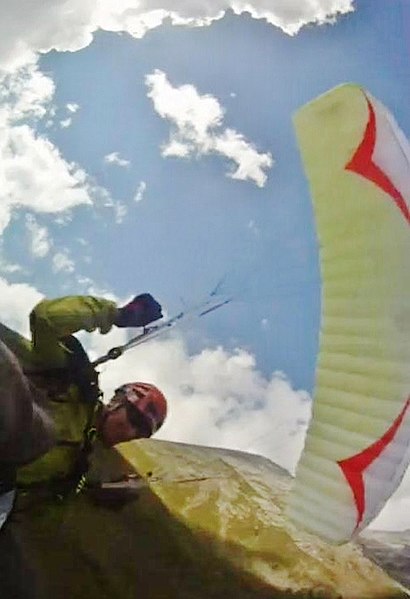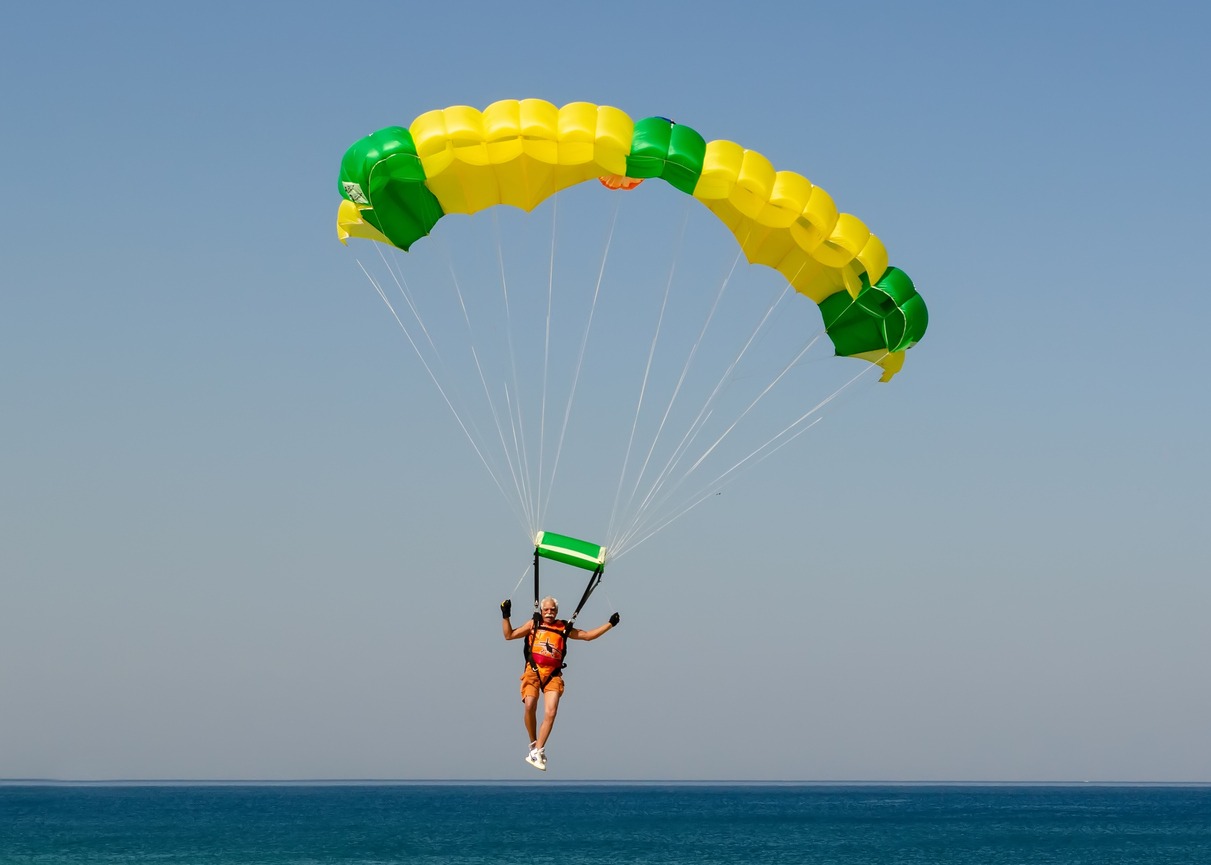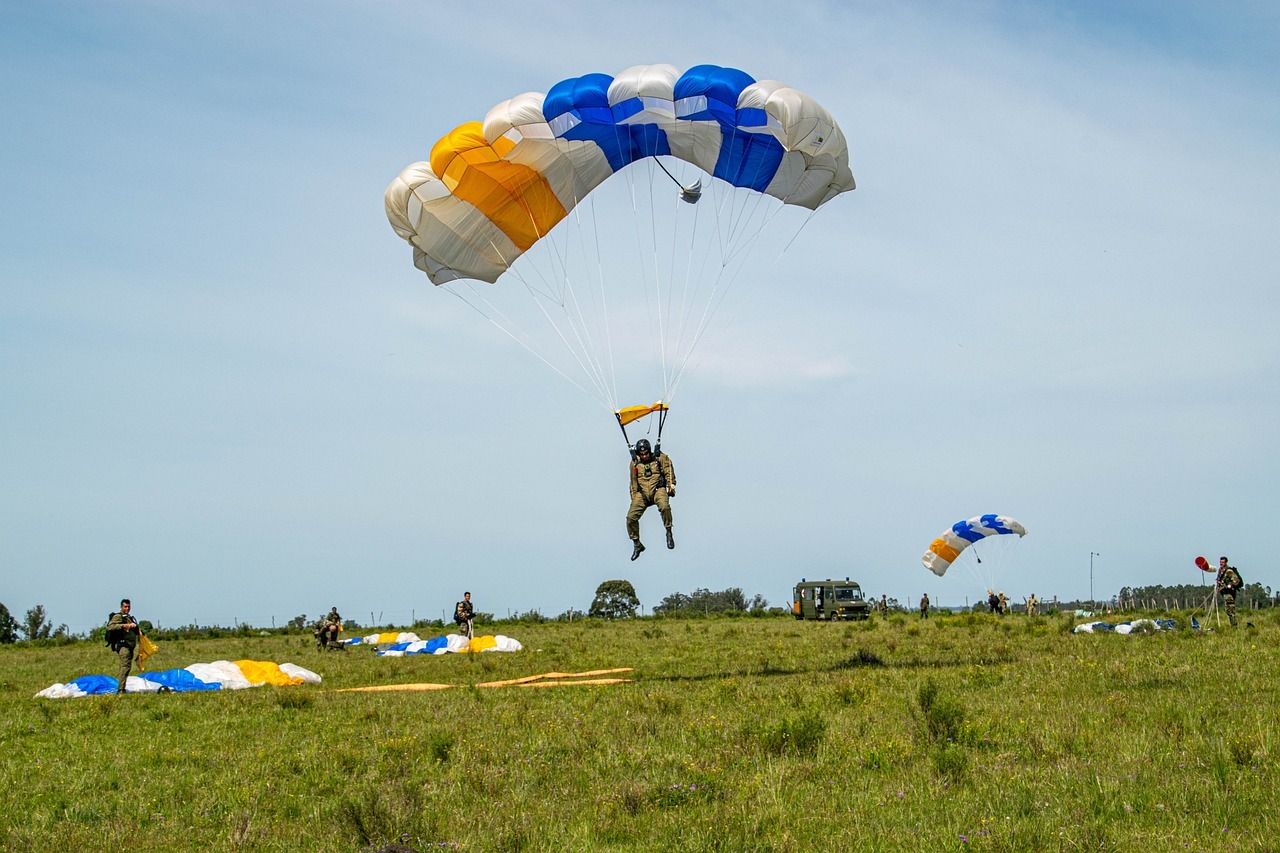Speed flying is a sport wherein you can defy gravity, dance with the wind, and plummet down steep slopes with breathtaking speed. It’s a relatively new extreme sport that has seen a surge in popularity, driven by the keen interest and active participation of skydivers, kite surfers, skiers, paragliders, and other adventure sports enthusiasts seeking the exhilaration of high-speed mountain descents.
In this article, let us unveil the realm of speed flying.
What is Speed Flying?
Speed flying is an extreme winter sport combining paragliding and skiing elements. It involves flying down steep slopes or mountainsides using a small, high-performance paraglider wing and typically wearing skis or a snowboard. The concept is to use the glider to control the descent and catch a lift from the wind to maintain flight as much as possible.
Speed flying requires a combination of skiing or snowboarding skills, paragliding knowledge, and experience in managing the speed and control of the wing. It demands a high level of proficiency and understanding of the equipment, weather conditions, and terrain to ensure safety. Due to the nature of the sport, speed flying is considered an advanced activity and is generally not recommended for beginners.
Based on paragliding principles, this sport involves using specialized wings to achieve rapid flights down hills. Unlike the serene gliding and soaring of traditional paragliding, speed flying relies on smaller wings, typically between 12 and 18 square meters in size, with a higher wing loading to enable high-speed travel. The more skilled pilots can perform close-to-terrain flights, making rapid descents that require expert piloting abilities and training.
Note that speed flying can also be practiced in non-snowy environments, such as on steep grassy slopes or rocky mountainsides. In these cases, participants typically use specialized footwear designed for traction and maneuverability on different surfaces.
As with any extreme sport, speed flying carries risks, including the potential for accidents, injuries, and adverse weather conditions. Due to the small size and highly loaded wing, it demands precision from the pilot, so professional guidance is highly essential.
Who Can Speed Fly?
Speed flying is an exciting sport that’s only for some. It combines paragliding and skiing skills in a unique way, requiring a gradual learning process to master this thrilling art. As with any extreme sport, take your time and don’t rush into it. To safely enjoy speed-flying, you’ll need excellent experience in both paragliding and skiing, with a keen awareness of mountain, weather, and equipment conditions.
Not every launch guarantees a full flight, and you may not be able to relaunch to continue your journey. Off-piste skiing and mountaineering skills are essential for safely navigating the mountain terrain. Lastly, remember that speed-flying is prohibited on all marked or prepared pistes. So, if you’re an experienced adventurer seeking a new challenge, this sport is for you!
History of Speed Flying
Before we move on to the basics of speed flying, let’s talk about how it came to be.
During the late 1970s, French mountaineers pioneered the practice of parachuting on foot (ground-launched) and skiing down steep mountains. Over time, these parachute advancements led to the development of larger and more easily launchable wings, known today as paragliders. However, ground-launched parachute techniques remained somewhat forgotten. Nearly two decades later, with material advancements and inspiration from parachute dive events, a new generation of French and American pilots emerged.
In 1996, a foot-launched parachute slalom competition called blade running (or runner) took place in the western United States, followed by blade raids in 2005. An American stunt parachute team further popularized the sport by creating a thrilling video showcasing mountain slope descents. In 2004, a team member established the first “ground launch school” for foot-operated parachutes in California, USA.
Around 2005, a group of French pilots began experimenting with improved parachute and parafoil kite designs. François Bonn, a paraglider test pilot, was unsatisfied with the performance of the stepping parachute and contributed to the development of the first-speed wing design known as the Jinnano. This design laid the foundation for subsequent commercial wings, ranging from 9 to 14 square meters, specifically designed for speed, portability, and lower glide ratios.
Today, speed gliders are manufactured by over 30 companies worldwide. In January 2007, France hosted its inaugural annual speed flying competition, “Speed Flying Pro Les Arcs.” The sport saw considerable growth, especially in France, and Switzerland is estimated to have 3,000-5,000 speeding pilots globally. Speedwing pilots have garnered media attention for their daring flights from locations like Aconcagua in the Andes and various peaks in the Alps.
Speed flying continued to grow in popularity and recognition as an adventure sport. It gained exposure through videos and media coverage, showcasing the exhilarating flights and breathtaking descents. Pilots began pushing the boundaries of speed and maneuverability, exploring more challenging terrain and executing acrobatic maneuvers during flights. It remains a niche sport, attracting a dedicated community of enthusiasts who seek the thrill of combining paragliding and skiing or snowboarding.
The sport has established airfields worldwide, including dedicated ski fields at several French resorts, and boasts over 100 instructors in around 20 countries. Speed flying, speed riding, ski gliding, and other notation forms have emerged as different names for this exhilarating air sport.
Speed Flying vs. Paragliding and Parachuting
Speed flying is a unique hybrid sport that melds aspects of both paragliding and parachuting, resulting in a thrilling and distinct activity. Similar to paragliding, speed flying involves launching from a slope with the wing already inflated by the incoming air. However, the fundamental difference lies in the purpose and experience: speed flying aims to deliver a fast and exhilarating ride in close proximity to the slope, whereas paragliding typically seeks to maintain longer and gentler flights.
Regarding landing techniques, speed flying shares similarities with parachuting, as both utilize fast landing methods. However, parachuting or skydiving involves jumping from a plane or fixed object (base jumping), and the parachute’s primary function is to arrest the free fall. In contrast, speed flying emphasizes the excitement of rapid descents near the terrain.
Here are the ways speed flying compares to paragliding and parachuting:
Speed Flying vs. Parachuting
Equipment
Parachuting typically involves the use of a parachute, which consists of a large canopy made of fabric. Meanwhile, a smaller, high-performance paraglider wing is used in speed flying.
Technique
Speed flying combines elements of paragliding and skiing/snowboarding. Pilots launch themselves from a slope or a mountain and use the speed wing to control their descent. Meanwhile, parachuting involves jumping from an aircraft or a fixed object at a high altitude.
Purpose
Speed flying is primarily an adventure sport that allows participants to combine the excitement of skiing or snowboarding with the freedom of flying. Speed flying is often performed at lower altitudes and closer to the ground, providing a more intense and dynamic experience.
On the other hand, parachuting can serve different purposes. Parachuting serves various purposes, including recreational skydiving, sport parachuting competitions, military operations, and emergency/rescue situations. When it comes to extreme sports, parachuting is an important part of skydiving, where individuals jump from aircraft for the sole purpose of experiencing freefall and parachuting to the ground.
Training and Safety
Due to the technical nature of speed flying and the risks involved, proper training and experience are essential. Speed flying requires a high level of paragliding skills, skiing/snowboarding proficiency, and knowledge of aerodynamics and weather conditions.
Training in parachuting is less rigorous, and one can get proper training through certified skydiving schools.
Speed Flying vs. Paragliding
Equipment
Speed flying utilizes a small, high-performance paraglider wing specifically designed for speed and maneuverability. Speed wings are much smaller than regular paragliders, typically ranging from 8 to 14 square meters. The smaller size allows for faster descents and greater agility.
Paragliding uses a larger and more standard paraglider wing, usually ranging from 25 to 35 square meters. Paragliders have a higher aspect ratio and are designed for longer, more leisurely flights.
Technique
Speed flying involves launching from a slope or mountain and flying close to the ground. The primary focus is on fast descents and maintaining control while navigating the terrain. Speed flyers often use skis or a snowboard on snowy slopes to aid in take-off and landing.
On the other hand, paragliding typically involves launching from higher altitudes, such as hills or cliffs and focuses on staying aloft for extended periods. Paragliders can catch thermals and other rising air currents to gain altitude and enjoy longer flights.
Purpose
As mentioned earlier, speed flying is an adventure sport that offers a fast-paced, thrilling experience. Paragliding is more focused on relaxed, prolonged flights and enjoying the sensation of soaring through the air.
Training, Safety, and Pace
Speed flying requires high paragliding skills and skiing/snowboarding proficiency. Due to the faster and more challenging nature of speed flying, it is considered an advanced activity, so proper training is required.
On the other hand, paragliding is more beginner-friendly and leisurely and can be learned through certified paragliding schools. While it also involves risk, especially related to weather conditions and landing, the focus is more on understanding thermals, aerodynamics and developing piloting skills for longer flights.
Speed Flying and Speed Riding
Speed flying and speed riding are advanced disciplines within the realm of paragliding that involve utilizing small, high-performance paraglider wings to descend from various heights, such as mountains, swiftly. While speed flying and speed riding share many similarities, they differ in their launching techniques. Speed flying entails foot launching the speed wing, while speed riding is specifically a winter sport conducted on skis.
As the sport has matured over the years, standardized terms have emerged to distinguish between the individual activities of both the winter and summer aspects. Speed riding involves flying down snow-covered slopes while maintaining frequent ground contact using skis. On the other hand, speed flying encompasses flying down snow-free slopes after foot launching, with no ground contact until the landing.
The term “speed-flying” serves as the overarching definition encompassing all activities related to the sport, encompassing both riding and flying, as well as any variations that lie between these two primary aspects.
Equipment for Speed Flying
Here are the things you need for speed flying:
Speed Wing
The heart and soul of speed flying lies in its unique wing, known as the speed wing, speed glider, or speed flyer. Crafted from ripstop nylon fabric treated with polyurethane or silicone coating, reinforced with Kevlar or Dyneema lines protected by an outer sheath, and boasting Mylar reinforcement on the leading edge cell openings, these wings share similarities with paragliders. However, they have a distinct characteristic that sets them apart – their size. Speed wings are only about half the size of the average paraglider, ranging from 8 to 14 square meters. The smaller size gives them a significantly lower glide rate, rendering them ideal for flying close to slopes.
The reduced size also makes speed gliders exceptionally agile and capable of soaring in windy environments, making them a preferred choice for hikers looking to minimize weight. As they take to the skies, speed gliders reach impressive speeds ranging from 20 to 95 miles per hour, surpassing the 12 to 50 miles per hour range of paragliders. While sharing some traits with Ram-air Parachutes, speed wings differentiate themselves by their lighter weight, enhanced maneuverability, absence of a pilot chute or slider, and lack of suitability for arresting freefall.
Parachutes for paragliders and speed wings are categorized similarly to skydiving gear, with different classes denoted by letters (A, B, C, D, Competition, and Acro for paragliders). Speed wings may not always have specific classifications, but they can be categorized as Mini Wings or Speed Wings based on their size and characteristics. For individuals transitioning from skydiving to paragliding or speed flying, starting with an A or low-end B wing is recommended, progressing to Mini Wing before attempting Speed Wing flying, if desired.
In recent developments, newer hybrid-wing designs, also known as mini-wings, have emerged, enabling high-speed “hike and fly” experiences in mountainous regions. These hybrid wings can soar in strong laminar winds and are thermally similar to paragliders. They can also be adjusted to allow for a more traditional speed flying descent.
Full-size paragliders undergo extensive testing by independent test houses to assess their flight safety characteristics. However, the same level of testing and certification is not widely available for speed-flying wings, resulting in limited independent data on their flight safety characteristics. While a potential flight safety standard for speed wings may be developed in the future, currently, most speed flying wings are classified as uncertified.
When pilots opt to fly uncertified wings, they are required to acknowledge and accept the additional risks associated with flying an uncertified wing without acceptable independent verification of airworthiness.
Harness
Skydiving harnesses tend to have consistent designs across different brands. In contrast, paragliding harnesses offer various options based on the type of flying intended. Beginners in paragliding should prioritize harnesses with appropriate back padding to minimize the risk of severe injury. However, in speed flying, harnesses are typically designed with a simpler structure and often lack back protection.
Pilots have the flexibility to choose from different harness styles – a standing harness akin to those worn with parachutes, a seated harness with straps, or a seated harness equipped with protective padding similar to paragliding gear. This adaptability allows pilots to fine-tune their flying experience based on their preferences and the conditions they encounter.
Protection equipment
Protection equipment, such as helmets, ensures safety during paragliding and speed flying. Regular skydiving helmets may not be suitable for these activities. Instead, rated helmets specifically designed for paragliding and speed flying should be used. Additional protective gear, like knee pads and suitable boots, may be considered to safeguard against potential obstacles encountered during mountain flying.
Ski/Snowboard equipment
When speed flying on snow-covered slopes, participants typically wear skis or a snowboard. Skis are commonly used due to their maneuverability and ease of use. The choice between skis or a snowboard depends on personal preference and experience.
GPS/altitude device (optional)
Some speed flyers use GPS devices or altimeters to monitor their speed, altitude, and other flight data. These devices can provide valuable information during the flight and help maintain safe parameters.
Appropriate clothing
Appropriate clothing is crucial for speed flying, considering factors like weather conditions, temperature, and wind resistance. Flyers often wear layers for insulation, waterproof outerwear, and gloves for warmth and protection.
Learning How to Speed Fly
Learning to fly, whether it’s paragliding or speed flying, requires proper training and preparation. Taking a paragliding course from a certified instructor is highly recommended before attempting your first flight. However, there are steps you can take to expedite your learning process.
Ground handling, which involves mastering control of your glider on the ground, is an essential skill. Many drop zones have old gliders that may no longer be suitable for flying but are perfect for honing ground handling skills. You can practice kiting the glider safely on flat ground with the help of a friend or by accessing online videos. Developing strong kiting skills will make you a more successful pilot. Even after completing your course, it’s beneficial to continue kiting a few times a week to gain a better understanding of your glider’s reactions and build a diverse set of kiting skills for take-offs.
The steps of learning to paraglide or speed fly generally start with the following:
- Learning to kite with old equipment on flat ground.
- Taking a paraglider course with a certified instructor.
- Obtaining PP2 certification (an intermediate paragliding certification level).
- Educating yourself on terrain, weather, self-rescue, and buddy rescue to enhance safety and preparedness.
If your goal is to pursue speed flying, after obtaining PP2 certification, you should focus on learning kiting skills specific to the wing you intend to use. Seek guidance from an appropriate instructor or mentor. Training on grassy hills allows you to start with short straight flights, practicing launch and landing until you gain the basic skills necessary to explore different locations.



